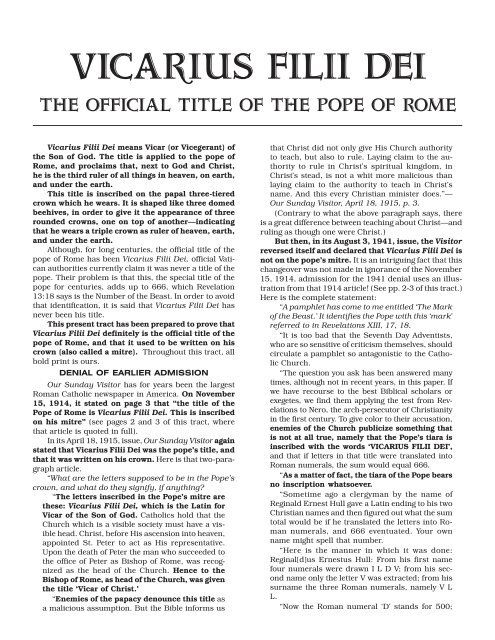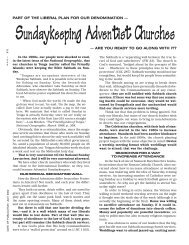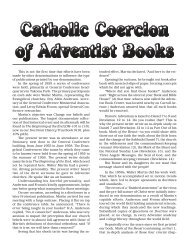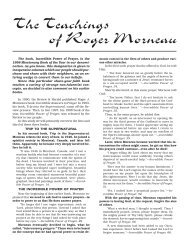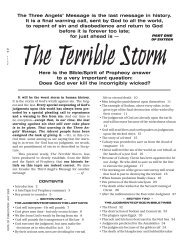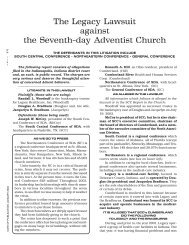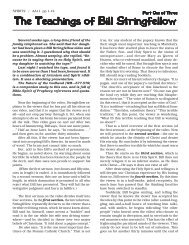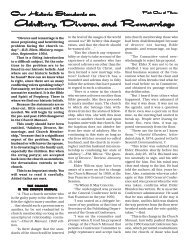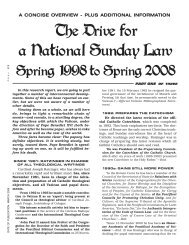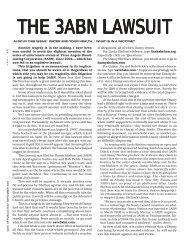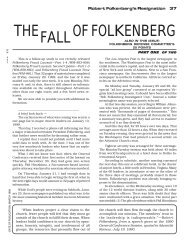WM697 VICARIUS FILII DEI - SDADefend
WM697 VICARIUS FILII DEI - SDADefend
WM697 VICARIUS FILII DEI - SDADefend
You also want an ePaper? Increase the reach of your titles
YUMPU automatically turns print PDFs into web optimized ePapers that Google loves.
Vicarius Filii Dei<br />
the Official Title of the Pope of Rome<br />
Vicarius Filii Dei means Vicar (or Vicegerant) of<br />
the Son of God. The title is applied to the pope of<br />
Rome, and proclaims that, next to God and Christ,<br />
he is the third ruler of all things in heaven, on earth,<br />
and under the earth.<br />
This title is inscribed on the papal three-tiered<br />
crown which he wears. It is shaped like three domed<br />
beehives, in order to give it the appearance of three<br />
rounded crowns, one on top of another—indicating<br />
that he wears a triple crown as ruler of heaven, earth,<br />
and under the earth.<br />
Although, for long centuries, the official title of the<br />
pope of Rome has been Vicarius Filii Dei, official Vatican<br />
authorities currently claim it was never a title of the<br />
pope. Their problem is that this, the special title of the<br />
pope for centuries, adds up to 666, which Revelation<br />
13:18 says is the Number of the Beast. In order to avoid<br />
that identification, it is said that Vicarius Filii Dei has<br />
never been his title.<br />
This present tract has been prepared to prove that<br />
Vicarius Filii Dei definitely is the official title of the<br />
pope of Rome, and that it used to be written on his<br />
crown (also called a mitre). Throughout this tract, all<br />
bold print is ours.<br />
DENIAL OF EARLIER ADMISSION<br />
Our Sunday Visitor has for years been the largest<br />
Roman Catholic newspaper in America. On November<br />
15, 1914, it stated on page 3 that “the title of the<br />
Pope of Rome is Vicarius Filii Dei. This is inscribed<br />
on his mitre” (see pages 2 and 3 of this tract, where<br />
that article is quoted in full).<br />
In its April 18, 1915, issue, Our Sunday Visitor again<br />
stated that Vicarius Filii Dei was the pope’s title, and<br />
that it was written on his crown. Here is that two-paragraph<br />
article.<br />
“What are the letters supposed to be in the Pope’s<br />
crown, and what do they signify, if anything?<br />
“The letters inscribed in the Pope’s mitre are<br />
these: Vicarius Filii Dei, which is the Latin for<br />
Vicar of the Son of God. Catholics hold that the<br />
Church which is a visible society must have a visible<br />
head. Christ, before His ascension into heaven,<br />
appointed St. Peter to act as His representative.<br />
Upon the death of Peter the man who succeeded to<br />
the office of Peter as Bishop of Rome, was recognized<br />
as the head of the Church. Hence to the<br />
Bishop of Rome, as head of the Church, was given<br />
the title ‘Vicar of Christ.’<br />
“Enemies of the papacy denounce this title as<br />
a malicious assumption. But the Bible informs us<br />
that Christ did not only give His Church authority<br />
to teach, but also to rule. Laying claim to the authority<br />
to rule in Christ’s spiritual kingdom, in<br />
Christ’s stead, is not a whit more malicious than<br />
laying claim to the authority to teach in Christ’s<br />
name. And this every Christian minister does.”—<br />
Our Sunday Visitor, April 18, 1915, p. 3.<br />
(Contrary to what the above paragraph says, there<br />
is a great difference between teaching about Christ—and<br />
ruling as though one were Christ.)<br />
But then, in its August 3, 1941, issue, the Visitor<br />
reversed itself and declared that Vicarius Filii Dei is<br />
not on the pope’s mitre. It is an intriguing fact that this<br />
changeover was not made in ignorance of the November<br />
15, 1914, admission for the 1941 denial uses an illustration<br />
from that 1914 article! (See pp. 2-3 of this tract.)<br />
Here is the complete statement:<br />
“A pamphlet has come to me entitled ‘The Mark<br />
of the Beast.’ It identifies the Pope with this ‘mark’<br />
referred to in Revelations XIII, 17, 18.<br />
“It is too bad that the Seventh Day Adventists,<br />
who are so sensitive of criticism themselves, should<br />
circulate a pamphlet so antagonistic to the Catholic<br />
Church.<br />
“The question you ask has been answered many<br />
times, although not in recent years, in this paper. If<br />
we have recourse to the best Biblical scholars or<br />
exegetes, we find them applying the test from Revelations<br />
to Nero, the arch-persecutor of Christianity<br />
in the first century. To give color to their accusation,<br />
enemies of the Church publicize something that<br />
is not at all true, namely that the Pope’s tiara is<br />
inscribed with the words ‘<strong>VICARIUS</strong> <strong>FILII</strong> <strong>DEI</strong>’,<br />
and that if letters in that title were translated into<br />
Roman numerals, the sum would equal 666.<br />
“As a matter of fact, the tiara of the Pope bears<br />
no inscription whatsoever.<br />
“Sometime ago a clergyman by the name of<br />
Reginald Ernest Hull gave a Latin ending to his two<br />
Christian names and then figured out what the sum<br />
total would be if he translated the letters into Roman<br />
numerals, and 666 eventuated. Your own<br />
name might spell that number.<br />
“Here is the manner in which it was done:<br />
Reginal[d]us Ernestus Hull: From his first name<br />
four numerals were drawn I L D V; from his second<br />
name only the letter V was extracted; from his<br />
surname the three Roman numerals, namely V L<br />
L.<br />
“Now the Roman numeral ‘D’ stands for 500;
the L stands for fifty and since there are three ‘L’s’<br />
they would effect 150; the three ‘U’s”, which are<br />
identified with a ‘V’ would mean 15 more, and the<br />
letter ‘I’ would signify one—the total 666.<br />
“The first thirty Popes lived in the golden age of<br />
Christianity and twenty-nine of them died martyrs<br />
for Christ. Imagine any one of them being designated<br />
the ‘beast’ of the Apocalypse. Among the 262<br />
Popes who ruled over the Catholic Church from<br />
the time of Christ, all but four or five, even according<br />
to the unwilling admission of unfriendly historians,<br />
were among the holiest men of their times.<br />
The few unworthy ones, who were placed on the<br />
throne of Peter reached that position through the<br />
intrigue of civil rulers. Only five Popes have ruled<br />
over the Church during the greater part of the last<br />
century and every person, unless he be absolutely<br />
uninformed or ignorant, would rate them among<br />
the saintliest people. We say ‘unless the person were<br />
uninformed or ignorant,’ designedly, because the<br />
lives of these Popes have been written by Protestants<br />
as well as Catholics.<br />
“It is very strange that people can regard themselves<br />
as religious and still engage in an apostolate<br />
of vituperation and slander.”—Our Sunday Visitor,<br />
August 3, 1941, issue, p. 7.<br />
(Contrary to the above statement, many history<br />
books have been written about the evil pontiffs and the<br />
fact there were so many of them.)<br />
The 1941 statement, just above, clearly denies facts<br />
which the first maintained. Since 1941, the position of<br />
Rome has been that Vicarius Filii Dei is not, and has<br />
never been, a title of the pope, nor is it on his crown.<br />
But history teaches us something far different. Consider<br />
these facts:<br />
The Donation of Constantine was one of the most<br />
important ancient documents drafted by Rome. Although<br />
a Vatican forgery, it was considered to be an extremely<br />
important legal document. Written about A.D.<br />
760, it declared that Constantine had given much of the<br />
land and rulership of Italy to the pope. The document<br />
said that the pope’s title was Vicarius Filii Dei.<br />
“The Donation of Constantine [is] . . the most<br />
famous forgery in European history. The Donation<br />
of Constantine (Constitutum Constantini), written<br />
probably not long after the middle of the eighth<br />
century, became widely known through its incorporation<br />
in the Pseudo-Isidorian Decretals (about<br />
847-853). Parts of it were included in most of the<br />
medieval collections of canon law.”—Christopher<br />
B. Coleman, The Treatise of Lorenzo Valla on the<br />
Donation of Constantine, Yale University edition,<br />
p. 1.<br />
Here is the actual text of part of this Donation in<br />
English:<br />
“The Emperor Constantine the fourth day after<br />
his baptism conferred this privilege on the Pontiff<br />
of the Roman church, that in the whole Roman<br />
world priests should regard him as their head, as<br />
judges do the king . . As the blessed Peter is seen<br />
to have been constituted vicar of the Son of God<br />
[Latin: Vicarius Filii Dei] on the earth, so the Pon-<br />
tiffs who are the representatives of that same chief<br />
of the apostles, should obtain from us and our empire<br />
the power of a supremacy greater than the<br />
clemency of our earthly imperial serenity is seen<br />
to have conceded to it.”—Op. cit., p. 11.<br />
Here is the key sentence in the original Latin text:<br />
“Sicut B. Petrus in terris vicarius Filii Dei esse<br />
videtur constitutus, ita et Pontifices, . .”—Op. cit.,<br />
p. 12.<br />
Although later unmasked as a forgery (written by<br />
priests about A.D. 760, and not by the Emperor<br />
Constantine about A.D. 336), this document carefully<br />
stated that the pope’s title as vicegerent to God was<br />
the basis of his authority.<br />
Here is another Catholic statement on this subject:<br />
“The highest power in the world, the Vicar of<br />
the incarnate Son of God . . sat in his tribunal . .<br />
“[His is] the temporal power of the Vicar of<br />
Jesus Christ.”—Henry Edward Manning, The<br />
Temporal Power of the Vicar of Jesus Christ, London:<br />
Burns and Lambert, 1862, pp. 46, 140.<br />
It should come as no surprise that the pope is said<br />
to be next to God in power and authority, for he is frequently<br />
said to possess the authority of God.<br />
“The pope is of so great authority and power<br />
that he can modify, explain, or interpret even divine<br />
laws . . Petrus de Ancharano [d. 1416] very<br />
clearly asserts this in Consil. 373, no. 3 verso:<br />
“ ‘The pope can modify divine law, since his<br />
power is not of man, but of God, and he acts in<br />
the place of God upon earth, with the fullest power<br />
of binding and loosing his sheep.”—Lucius Ferraris,<br />
“Papa,” art 2, in his Prompta Bibliotheca [Handy<br />
Library], Vol. 6, Venice: Gaspar Storti, 1772, p. 29<br />
[translated from the Latin].<br />
“Hence the Pope is crowned with a triple crown,<br />
as king of heaven and of earth and of the lower<br />
regions [infernorum].”—Op. cit., p. 26.<br />
“We define that the Holy Apostolic See and the<br />
Roman Pontiff holds the primacy over the whole<br />
world, and that the Roman Pontiff himself is [1]<br />
the successor of the blessed Peter, prince of the<br />
apostles; and [2] the true vicar of Christ, [3] the<br />
head of the whole church, and [4] the father and<br />
doctor of all Christians; and that to him, in the<br />
blessed Peter, was given, by our Lord Jesus Christ,<br />
full power to feed, rule, and govern the universal<br />
church, as is contained also in the acts of the ecumenical<br />
councils, and in the sacred canons.”—<br />
Council of Florence, Session XXV, July 6, 1439,<br />
Definitio, in J.D. Mansi, ed., Sacrorum Conciliorum<br />
[Holy Councils], Vol. 31, Col. 1031 [translated from<br />
the Latin].<br />
“We [the pope] hold upon this earth the place of<br />
God Almighty.”—Pope Leo XIII, Encyclical Letter<br />
“The Reunion of Christendom,” dated June 20,<br />
1894, translated in The Great Encyclical Letters<br />
of Pope Leo XIII, New York: Benziger, 1903, p. 304.<br />
TRAIL TRAIL GUIDES<br />
GUIDES<br />
BOX 300 - ALTAMONT, TN 37301 USA


